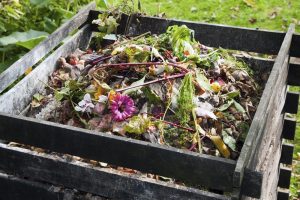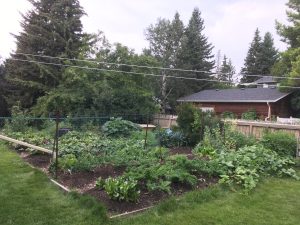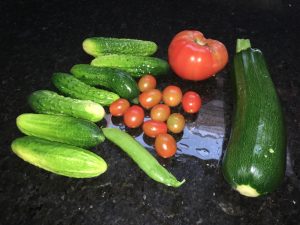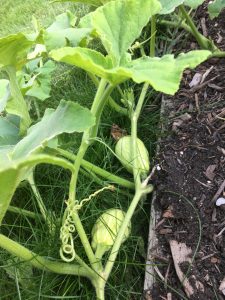The very best way to use your SoilMatrix Biochar
SoilMatrix Newsletter No. 13 (Biochar Co-Composting)
Making the very best possible use of your SoilMatrix Biochar… in your compost.
This edition of the SoilMatrix Newsletter is all about using biochar in your compost-making process as a very good first step in preparing a great garden soil amendment. If you want to know why adding biochar to your compost bin works so well, read on…

Compost made from kitchen scraps and yard waste with biochar as an ingredient
That’s right! If you are willing to be patient with your soil enhancing activities, sprinkle a cup of biochar into your compost bin for every 20 cups of added material and keep it blended with all the input materials remembering to keep close to a ratio of 25 to 1 carbon to nitrogen materials. Biochar co-composting is probably the best possible way to prepare your biochar for your garden.

The SoilMatrix Garden on August 3, 2018

An average evenings harvest from the SoilMatrix Garden
We already know that biochar blended with finished compost makes a great soil amendment to promote healthy plant growth. All you need to do is run a Google search to find a large amount of information on this. However, why include biochar in the actual compost making process – “biochar Co-composting”? I am suggesting this based on my own experience and a recent article published in “Nature Communications”1. The article: “Organic Coating on Biochar Explains its Nutrient Retention and Stimulation of Soil Fertility” is written by a group of well respected biochar researchers: Nikolas Hagemann, Stephen Joseph, Hans-Peter Schmidt, and a host of others.
The secret is in the nutrient-rich organic coating that forms on surfaces of co-composted biochar. Not only does this coating cover the outer surfaces of biochar particles, but it makes its way into the inner pores as well2. In the referenced article, a number of methods were used including high-resolution spectro-microscopy and mass spectrometry to observe the organic coating. Moreover, a number of other measurements methods were used to determine that the organic coating contributes to moisture retention and nutrient retention.
References:
- Nikolas Hagemann, Stephen Joseph, Hans-Peter Schmidt, et al, “Organic coating on biochar explains its nutrient retention and stimulation of soil fertility”, Nature Communications, October, 2017, https://www.nature.com/articles/s41467-017-01123-0.pdf?origin=ppub
- http://www.lightsource.ca/news/details/scientists_discover_why_biochar_fertilizers_work_so_well.html
The authors of this paper also believe that biochar’s soil enhancing properties are determined by the formation of this organic coating on biochar surfaces and not the positive and negative charges on its surfaces as previously believed. This means that biochar that is added to soils without having time to acquire such an organic coating, depends on the eventual formation of such a coating before all the benefits of biochar soil amendment is realized.
Although biochar is often quoted as having a number of positive impacts on soil properties and structure, i.e. porosity increase, nutrient and moisture retention, upward pH adjustment for acidic soils, and stimulation of beneficial microbes, no real detailed mechanistic understanding of how biochar positively influences plant growth has been provided – not until now.
High applications rates of up to 10 tonnes per hectar (1 kg per m2) have been recommended in the past, which is currently uneconomic for industrial large scale agriculture. But recent research like that provided in the above article suggests that biochar should be combined with organic amendments (compost, animal manure, green manure, etc.) to increase soil fertility even while reducing the rate of biochar amendment. However, the mechanism that is at play when biochar is amended with organic components is not yet fully understood. A mechanistic understanding of how co-composting impacts biochar’s performance as a soil amendment is still needed to help develop lower cost organic biochar-based fertilizers that can promote higher crop yields with comparably smaller application rates of biochar.
The organic coating that has now been physically measured and observed on co-composted biochar was also observed to exist when biochar is aged in the soil along with organic materials, but this takes some time to develop – possibly one or more seasons.
Stay tuned as this line of biochar co-composting research continues to reveal how this organic coating actually benefits plants. Hint…it may have something to do with the benefits of soil organic carbon content for the health of soil microbiological life.

Butternut Squash
If you want to learn how this principle is being used in developing countries around the world see: https://www.unenvironment.org/news-and-stories/story/waste-not-want-not
Give it a try and let’s continue to learn from each other.

Comments